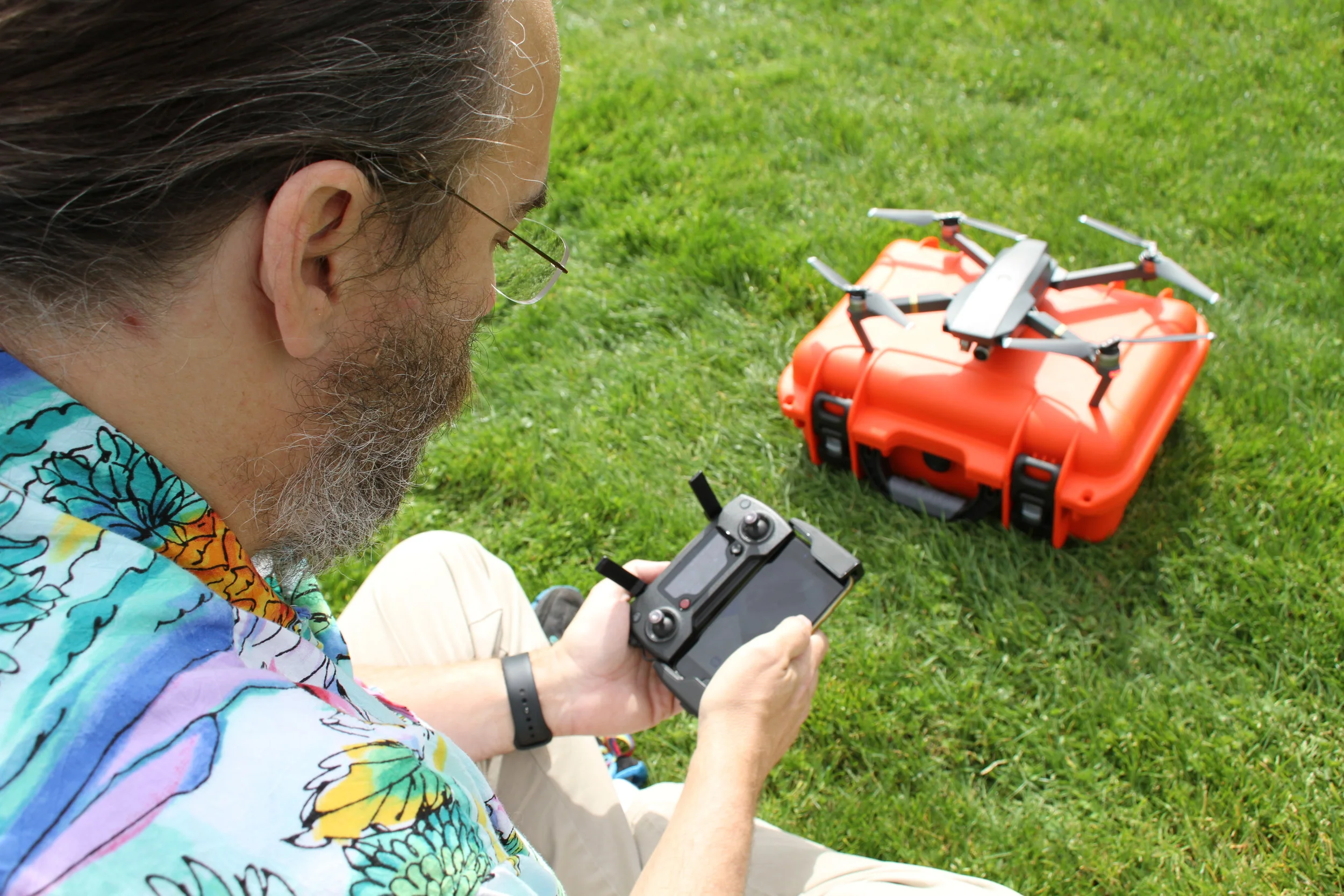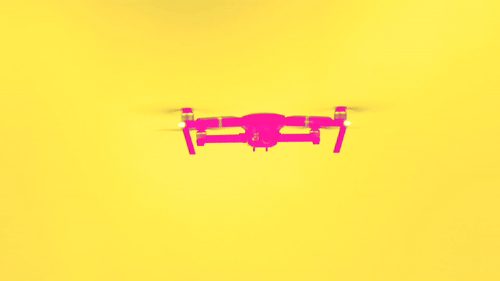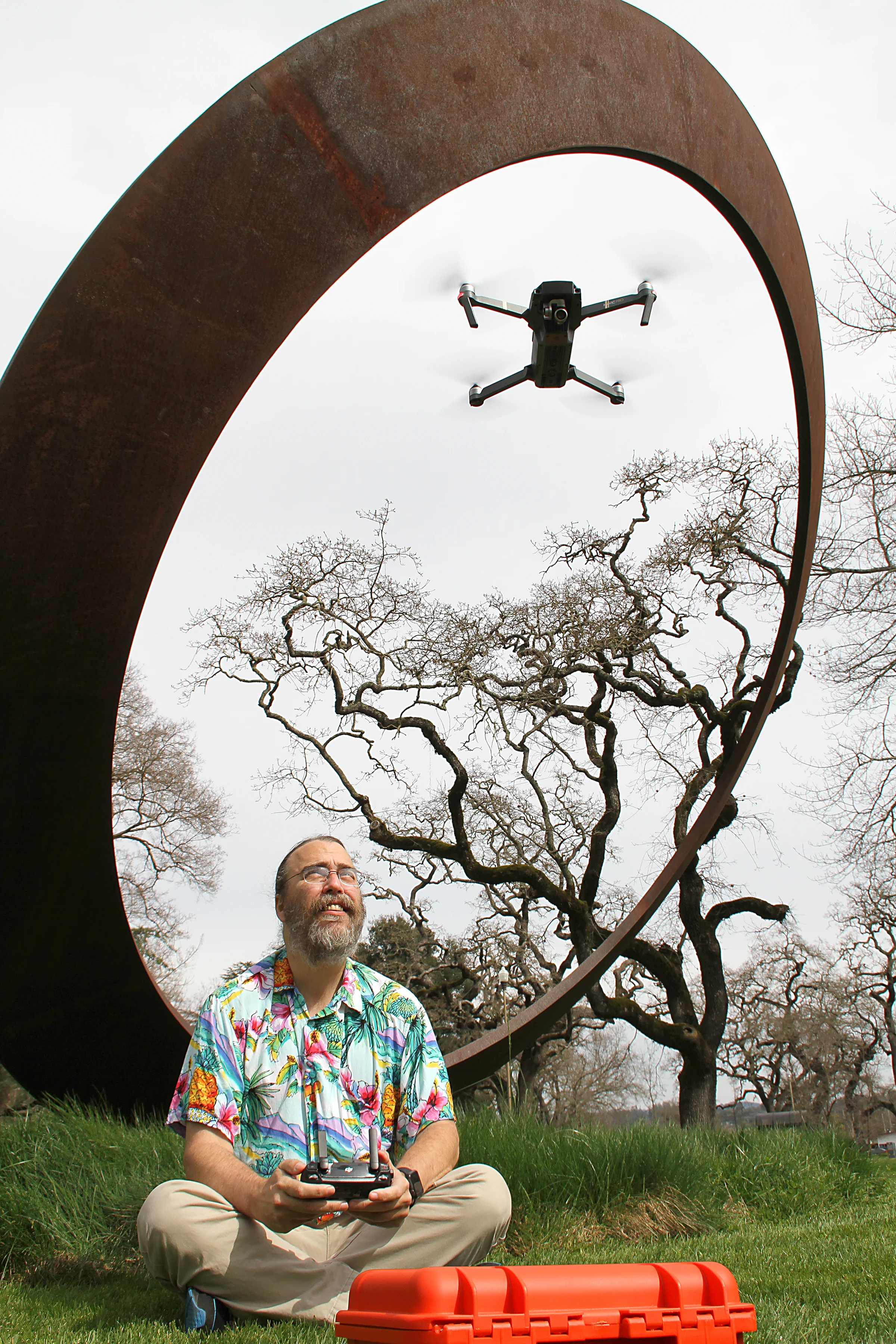(Article and Images by Ronny Joe Grooms first appeared in The Oak Leaf Newspaper, Fall 2017)
A new course is in the works for Fall Semester at SRJC that will prepare students to become commercial drone operators.
The course's creation is the inspiration and effort of Donald Laird, the Chair of the Computer Studies Department, and an instructor.
Over the last several years he has specialized in teaching what he calls "the fun stuff" in Computer Studies, including things like Intro to 3D-Printing, Social Media, Photoshop, and soon to be Intro to Drones.
A class proposal has been submitted to the SRJC curriculum committee and is pending approval sometime mid-March, and he hopes to teach the first drone course Fall Semester, 2017.
When asked why drones were coming to campus he explained how it is in line with the department's duty and mission as an attempt to stay abreast with what he calls, "the latest and greatest" technology and to bring students together with that technology "as fast as the bureaucracy will allow it . . ." as to offer a cutting-edge curriculum.
Last year Mr. Laird traveled to the Consumer Electronics Show, 2016 [CES 2016] a huge trade Show that occurs mid-January each year in Las Vegas, Nevada and he observed, “how incredibly popular it looked like drones were going to be,” he said.
“I personally owned a few small drones, maybe 4-inches across, just for toys, and I enjoyed it (them) and then as soon as I started observing them being used for practical purposes I thought, that's something we need to get in on."
Laird spent the better part of last year studying, determining what needed to be done, by keeping abreast with the Federal Aviation Administration’s construction of guidelines that essentially legalized drone flying last August and offered safety regulations for unmanned aircraft drones weighing less than 55 pounds that are conducting "non-hobbyist operations." These regulations are outlined by the FAA in the regulations know as SMALL UNMANNED AIRCRAFT RULE (PART 107) or 'Part 107' for short.
From a statement released by the FAA last year, U.S. Transportation Secretary Anthony Foxx said “We are part of a new era in aviation, and the potential for unmanned aircraft will make it safer and easier to do certain jobs, gather information, and deploy disaster relief,” and “We look forward to working with the aviation community to support innovation, while maintaining our standards as the safest and most complex airspace in the world.”
The FAA exam is offered through a series of federally approved testing centers. Laird tested in Santa Rosa at North Coast Air, a flight school located at Charles Schultz, Sonoma County Airport. The exam is a 63 question multiple choice test that Laird self-studied for and by passing the test is now a commercially licensed drone pilot. Under certain guidelines, a hobbyist is free to fly a drone without this license, but a pilot with a commercial drone license can operate their drone for hire and also train other pilots. Laird warns that even friendly exchanges between a drone hobbyist and business could be viewed as “commercial” in nature, so “It's best to be covered.”
When Laird received news of the new regulations and certification process he acted quickly and set forth on the path that allowed individuals to become certified commercial drone pilots nationwide.
Just a few months later, in January of 2017, Laird studied and passed the exam to became a certified drone pilot, quite possibly the campus's only one, he claims.
Having the commercial license cleared the way for Laird to teach a course on campus. He applied for a several of grants to fund the new drone program and was awarded them all. One grant was earmarked for instructional equipment and led to the purchase of the first drone and just this month, two more drones have arrived to join the department's inventory.
The second grant came by the Strong Workforce program. This is a California statewide initiative that endeavors to "lift low-wage workers into living-wage jobs" and "develop more workforce opportunity" the program's website said.
The FAA announcement that announced the new regulation cited encouraging numbers for job growth stating, "According to industry estimates, the rule could generate more than $82 billion for the U.S. economy and create more than 100,000 new jobs over the next 10 years."
The grant from Strong Workforce allows Professor Laird to coordinate with other colleges in the Bay Area. A regional program is in place that will allow SRJC to be the lead school in conjunction with as many as 6 other community colleges working together to create these drone programs to train students for employment related to the skill. A curriculum institute is being planned for sometime this Summer.
With the grants, Laird also anticipates that up to 10 or more drones will be purchased before year's end so that his upcoming new course will be "fully equipped."
Laird has purchased the school's first drone from DJI, one of the leading companies in consumer drone technology, they are best known for their white, stubby-legged Phantom series, and in late October 2016 introduced the Mavic Pro.
Following the trends closely, and looking to buy the most logical, effective and cutting-edge technology for an educational course Laird, "jumped right on it and ordered it the day they (the Mavic Pro) were announced for pre-order and took about two months to arrive." he said. With Laird's acquisition for the department SRJC became one of the first to acquire this model in California, he said.
The Mavic Pro is compact and fits in what could be compared to a camera case, which makes sense as the instrument comes with a high-resolution camera for both still and video image capture.
But the capabilities of the camera-equipped drone's do not end with videography and photography. The department's grant also allows Laird to purchase an infra-red camera that can be "deployed" for capturing heat signatures of what the drone flies over.
With the additional functionality provided by the infra-red accessory the drone can be utilized in search and rescue operations, agricultural land surveys, and much more.
Laird believes that applications of the technology are mostly limited by our imagination. Laird shared one example of a use in avian ecology that caught his attention, "I was just reading about a school today that is using drones for bird counts. They suspend a microphone off a long fishing line beneath a drone to capture bird calls." Normally when this work is done, ecologists would have to creep into the forest, which would inevitably "spook the birds" and this unavoidable consequence would affect the bird count numbers. But the drone flying at 100ft up with the microphone hanging 50ft down was able to capture pristine information as the drone flew over the coverage area."
As many career paths are appearing as the technology becomes more widespread, the course's goal is to prepare students for the exam and give them a strong foundation to become professional operators.
The course will have several parts to it, Laird explained. Part one is drone safety, not just how to fly them but how to fly them safely. Part two will explore drone's utility, their commercial and industrial uses and how those uses offer career opportunities and professional development. Part three is preparation for the certification exam.
Students who gained this skill might find new ways to work as a photographer or film-maker, an agricultural or ecological surveyor, public safety person, construction and building safety inspector are just a few examples.
Laird hopes to bring in guest speakers from the professional sector to share their expertise and experience of their particular focus and usage of this emerging technology.
Later, as the course develops, Laid sees his course as the "starting-point" for training with drones on campus but later other departments would offer industry-specific courses that build on that foundation and then focus skill-sets needed for careers in that department's particular field and interest.
Laird's first flights were as a hobbyist, and he shares stories about playing with little drones he called toys, a mere 4" in length, before being licensed. He describes them as difficult to fly. With many cheap, mass-produced toy models that seem like they are available for purchase almost anywhere, their performance can be disappointing. Even the slightest breeze or imperfect condition can make them almost impossible to fly, but crashing cheap drones is still fun and no big deal unless they end up in a tree, "I parked too many of those in the trees." Laird warned with a big smile.
His first flight with the new, professional drone was "almost too easy." He was "astonished" at how far the technology has come. With the stability and control capabilities of the new technology his concern about tree landings quickly subsided and soon he was "doing things with it I never thought I would do" like flying a $1,000 drone over open ocean bat Goat Rock State Beach and other local Pacific Beaches.
He had done numerous test flights on the ground before embarking on a mission over open water. "Granted the drone was only flying 50-feet from shore, but on the Pacific Coast 50-feet might has well have been 50-miles . . . That was terrifying but I felt confident with the thing." Laird said, "Having that ability, that they are so easy to fly, once you know how to do it, the key is knowing when and where you can do it."
When asked what the wildest thing he has heard about drone technology lately Laird starts describing "drone racing" and says this trend is something to watch developing and potentially something SRJC may look into "a little farther down the line." Laird said.
Drone Racing has become a popular international sport and in fact is more popular in other countries because the U.S. FAA regulations are "a lot tighter." Laird explained, in these races pilots will fly custom-built drones at speeds well over 100mph. Races take place in places like stadiums, were hoops will be attached to seats and racers flying around the stadium will fly "laps" around the stadium while navigating through the course of hoops at these high speeds.
Most of the pilots wear 1st-person goggles, that look like the popular new Virtual Reality or VR goggles, and give the pilot a real-time view from the drone's perspective as it speeds along the flight paths of the race. Last year the 'World Drone Prix', the largest drone race of its kind, took place in Dubai and 15-old British pilot won. Along with a trophy, the young man also took home a check of $250,000 for his victory out of the $1-million of prize money that was awarded to racers at the event.
Where is the tech going? "Everywhere," Laird says. During the research for his grant proposal, Laird looked at job projections statistics stemming from this technology and the data suggests thousands of jobs emerging as a result of this developing technology over the next few years. Not all of these jobs will necessarily be jobs specifically as a drone pilot but will the skill will be an enhancement or maybe even a job requirement for many positions in the future, Laird suggested.
Some of the newest advances are allowing for a more autonomous drone and communication between drones. Imagine a squadron of drones flying autonomously in unison like a school of fish or a murmuration of birds.
"Flying one drone is easy but flying 10 or 20 gets a little bit scary because you have to start to think in that 3rd dimension and that's tricky to do," Laird explained.
The technology is well within reach to create this scenario. Like many of the emerging technologies that are disrupting the status quo, drone usage has its fair share of practical and ethical questions. Laird is balanced in his enthusiasm and critique of the technology when asked about science fiction become reality in regard to visions of flying robots of death and spies in the sky everywhere.
Laird wants to address these concerns at the level of education. "My main concern is people flying who don't know what they are doing. I jokingly call them, spinning-propeller-blades-of-death, I don't really mean that, but they can be dangerous. The larger the drone, the heavier it is, the more inertia, and I have seen people flying into buildings and places they shouldn't be. It's addressing that type of operator error (that) is part of the reason I want to do this class is to train people the correct way of doing things."
"Unfortunately there are a lot of people who have a negative perception of drones," Laird said, mostly because of the view that hey will be used to invade privacy or worse. This view and debate follow a pattern in talk about technology where we see a few bad examples of pilots gone wrong ruining the image of the technology and the responsible pilot's good and useful operation.
"That one stupid (drone pilot) is going to be the one who gets the press," Laird lamented. "And so the fewer of those we can have the better."
There are many reports from last year's horrendous wildfires in California of drone operators interfering with firefighters ability to fight the fire because of overzealous drone-camera operators seeking footage of the fires. Laird is quick to point out that sometimes the dangers are not inherent in the technology, it's the irresponsibility of the users.
"Before drones, the same individuals used to drive their dirtbike or ATV" to get into the (fire) scene and stake out places to get views which also sometimes caused a hindrance or emergency situation.
The analysis of a technology separate from its operator seems impossible to escape. From Laird's view, "Operator Error" is the most real danger and a barrier to safety with technology. Laird seems poised to join the efforts of educators to take that barrier down one student at a time.
It is an ongoing and fascinating conversation in the case of this technology and others that will continue as innovation, culture, and society strives for equilibrium in an ever changing world. The next level question is where do operators stand as technology continues its trend of becoming more autonomous and automated? Will our ethics as 'operators' be challenged in new ways and will new concerns about the technology's inherent qualities arise despite their creators and operators intent or fallibility?
Time will tell but as Professor Laird sees it, "People will be stupid with whatever the current technology is, but I just hope I can teach some of them to be a little less so."
HAPPY FLYING







